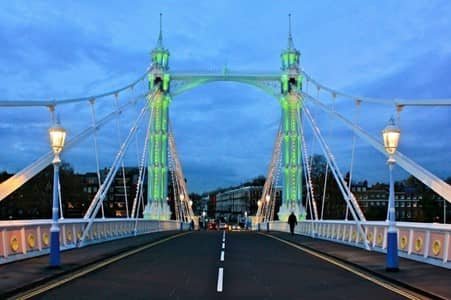Battersea’s river crossings
By Sally Sellers
Ancient crossings
Probably the first bridge across the Thames around London was a wooden Roman one. Excavation work for the foundations for Chelsea Bridge revealed objects of Roman origin, making it very possible that this was where Julius Caesar crossed. Yet there may well have been a much earlier walkway across the Thames near this site. The exciting discovery of the Battersea Shield suggests there was an Iron Age crossing here. This exquisite bronze shield-facing is now held in the British Museum.
London Bridge, built in 1209, remained the only dry crossing of the Thames until the 18th century so ‘watermen’ offered ferry services transporting people, horses and wagons from side to side and along the river. The men operating such craft in all weathers and tides, as well as those who transported goods by barge or lighter, required great knowledge and skill. Ferries were a lucrative business and whenever a bridge was proposed there was a petition against it from watermen and the wealthy ferry-owner. However this was not the case between Battersea and Chelsea. In 1766 the local inhabitants petitioned the House of Commons complaining of the danger and inconvenience of the ferry. Its owner, Lord of the Manor of Battersea Earl Spencer, decided he could make more money from a toll-bridge, leading to the construction of the first, wooden, Battersea Bridge.
Battersea Bridge
Nocturne in Blue and Gold. James Whistler’s painting of Old Battersea Bridge
An Act of Parliament authorised a stone bridge to be built on the course of the ferry, but at £83,000 this was deemed too expensive so the wooden bridge, designed by Henry Holland, opened in 1771. This did not provide the expected income and suffered frequent damage so by the second half of the nineteenth century it resembled a dilapidated ancient monument and was an obstruction to shipping. Nevertheless, in paintings and etchings artists showed the bridge as picturesque and even romantic. The most famous, Whistler’s Nocturne: Blue and Gold, portrays the bridge looming out of the river in a ghostly haze. This now hangs in Tate Britain and there is a statue of Whistler on the North End of today’s bridge. By 1883 constant repairs led to the bridge’s closure and a new one, designed by Bazalgette, was opened in 1890.
Albert Bridge
Albert Bridge
In 1860 Prince Albert proposed a new toll bridge connecting Battersea with Chelsea, but it failed to make profits and in 1879 it was freed from tolls. The octagonal tollbooths were left in place and today are the only surviving bridge tollbooths in London.
An innovative combination of a suspension and a cable-stayed bridge it had ornate cast-iron towers rising from four cylindrical piers. There were repeated concerns about the bridge’s strength and extensive strengthening and renovation works were needed. Measures taken to protect it from vibrations, when large numbers walked across, led to the nickname the Trembling Lady and the sign telling soldiers to break step when crossing.
Described in 1957 by John Betjeman as ‘one of the beauties of the London river’ Albert Bridge is a much photographed London landmark. The pink, blue and green paintwork was not just to enhance its appearance but also to increase its visibility for ships in fog and murky light. The lights were originally added for the Festival of Britain in 1951 and now at night it is splendidly illuminated by 4,000 LEDs.
Chelsea Bridge
In 1842 the Commission for Improving the Metropolis recommended a bridge be built as part of the plans to develop the unruly Battersea Fields area and create a public park. The bridge was officially opened in March 1858 by Queen Victoria and originally named after her.
Like the other local bridges there were problems of safety and deterioration which may explain the later name change to ensure any collapse was not connected to the Queen. In 1931 London County Council replaced the old structure with a suspension bridge carrying four lanes for the ever- increasing motor traffic. The new bridge, distinguished by restrained simplicity, was officially opened in May 1937.
Railway Bridges
Battersea Railway Bridge was originally named Cremorne after the eighteenth-century pleasure gardens nearby. Opened on 2nd March 1863, the same day as Clapham Junction Station (which was now linked to Kensington), it was never well-used and for decades carried only freight traffic. It has been been transformed by its incorporation into the modern London Overground network with trains now running over it every few minutes.
By contrast Grosvenor Bridge was busy from the start, carrying by far the most trains of any of London’s railway bridges. The first train crossed in 1860 but by 1963, after serious deterioration, it was reconstructed as ten separate bridges joined together to carry ten railway tracks. Travellers crossing today are rewarded with wonderful views of Chelsea and Albert Bridges one way and the redeveloped Nine Elms and Battersea Power Station the other.
A shorter version of this article is featured on the website of the Nine Elms Foundation and in their interpretive boards along the Thames. Click here to see it on their website.



